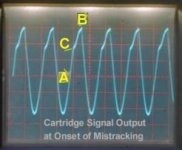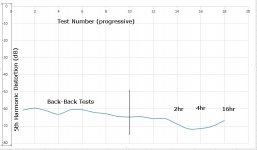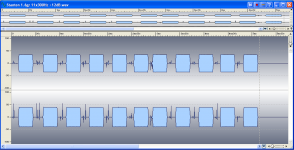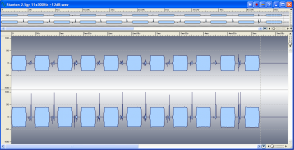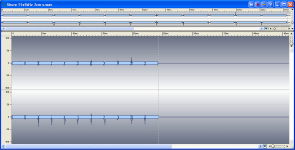Well, Shure attributed the changes to wear, at least in that article..........
However, I still can't come up with a way that a sine groove can wear in places that can make it more sine-like..............?
I can get that if one overall reduces harmonic distortion, then level of the fundamental will increase slightly in FFT, if total energy remains the same. So I think there is probably just one cause........
LD
However, I still can't come up with a way that a sine groove can wear in places that can make it more sine-like..............?
I can get that if one overall reduces harmonic distortion, then level of the fundamental will increase slightly in FFT, if total energy remains the same. So I think there is probably just one cause........
LD
I am thinking of the case that the harmonics are already inscribed in the grooves by the cutter head.
So with repeated plays these harmonics reduce either due to “groove polishing” from the playback needle, or reduce due to elastic deformation of the vinyl.
In the later case the harmonics should return to their original amplitude after a relaxation period, in the former case they wouldn’t.
George
So with repeated plays these harmonics reduce either due to “groove polishing” from the playback needle, or reduce due to elastic deformation of the vinyl.
In the later case the harmonics should return to their original amplitude after a relaxation period, in the former case they wouldn’t.
George
Also interesting is the change, or lack of change, in the 2nd harmonic depending on tracking force.
Surely someone on this august forum has a copy ofI am thinking of the case that the harmonics are already inscribed in the grooves by the cutter head.
So with repeated plays these harmonics reduce either due to “groove polishing” from the playback needle, or reduce due to elastic deformation of the vinyl.
In the later case the harmonics should return to their original amplitude after a relaxation period, in the former case they wouldn’t.
Pickups Key to Hifi, John Walton. (Paperback 0273401599)
or knows of a copy in a National Library archive.
It has some of the earliest SEM pics on the effect of playback on grooves which IIRC predate the RCA ones. He shows clear "polishing" if the "ETM" is 0.5mgm or less.
Also results of repeated play on THD.
For lucky, he achieved his 0.5mgm by utilizing EVIL cantilever resonances in his Deram ... as did Decca in their FFRR & FFSS cartridges.
To put this into perpective, original V15 from that period was still about 1mgm.
If anyone does find a copy, please scan it & make it public. I'm sure John / Jean Walton won't mind. 🙂
Well, for that to happen, the playback wear/indent pattern would have to match cutter-induced shape distortion pattern of the groove.......which seems a big ask, and lacking a reason IMO. However, IIRC Shure mooted something along those lines but also didn't know why that would be.I am thinking of the case that the harmonics are already inscribed in the grooves by the cutter head.
So with repeated plays these harmonics reduce either due to “groove polishing” from the playback needle, or reduce due to elastic deformation of the vinyl.
In the later case the harmonics should return to their original amplitude after a relaxation period, in the former case they wouldn’t.
George
For the 300Hz +12dB test tone, we can know the locations on the sine groove shape where stylus-groove force has maxima. Seems fair to assume this is where fastest wear/indent would happen.
In principle, the locations are somewhere between the zero crossings (peak velocity) and peak displacements (peak suspension spring displacement) of groove shape. This is illustrated in one of Yosh's own measurements (IIRC), where by happy coincidence he used the same 300Hz test HFN track as George used, except Yosh reduced tracking force until onset of mistracking, whilst looking at an oscilloscope trace of the cartridge output. So we can know the location on the grooveshape where onset of mistracking happens, which we can say is the point of maximum groove-stylus force (or close to it), as per Yamamoto.
Attached is a marked up image of Yosh's plot that shows the onset of mistracking, in terms of cartridge output, labelled at point C.
We can see that it agrees with the prediction of where maximum stylus-groove force should be.
However, also note that the mistracking is asymmetric, suggesting forces are asymmetric. This is because of the effect of tonearm offset angle on applied force at the zero crossing point, ie instantaneous skate force is not symmetrical.
For these reasons, should not wear/indentation lead to a progressively asymmetric groove shape, ie even-ordered distortion? But neither George's tests nor Shure's article suggest this, quite the opposite. And what's more, the region of groove needed to be worn/indented to become less triangular (fitting the observed harmonic pattern in George's tests), is not the region of maximum force........ it doesn't fit.
So I doubt Shure's explanation (IIRC) of wear that cancels cutting error, appealing as it might be. I think some more satisfying explanation is needed and still out there...........
LD
Attachments
Last edited:
IMO, for the 2.5g 300Hz@+12dB tests, there is no conclusion as to recovery, but a reasonable suggestion that within 16 hours rest, the original level of harmonics was not recovered.In the later case the harmonics should return to their original amplitude after a relaxation period, in the former case they wouldn’t.
Unfortunately, the plot is one of those 'all things to all men', but strictly there can be no conclusion IMO. Error bars preclude anything but suggestion. Here it is anyway......
LD
Attachments
As a final contribution to the issue, I think of playing a single tone track (300Hz or 1kHz) those 150 times and recording all these in one file or in a maximum of three files, without doing the post recording processing. I’ll upload these raw files and if one is interested he can slice them into individual playback files, clean each beginning and end from the needle drop/lift signals, trim and time align the files so they will be ready for analysis.
If there is interest, please suggest the signal frequency (300Hz or 1kHz), flat or RIAA playback mode and file characteristics (sampling freq/bit depth).
George
If there is interest, please suggest the signal frequency (300Hz or 1kHz), flat or RIAA playback mode and file characteristics (sampling freq/bit depth).
George
For the 300Hz +12dB test tone, we can know the locations on the sine groove shape where stylus-groove force has maxima. Seems fair to assume this is where fastest wear/indent would happen.
In principle, the locations are somewhere between the zero crossings (peak velocity) and peak displacements (peak suspension spring displacement) of groove shape. This is illustrated in one of Yosh's own measurements (IIRC), where by happy coincidence he used the same 300Hz test HFN track as George used, except Yosh reduced tracking force until onset of mistracking, whilst looking at an oscilloscope trace of the cartridge output. So we can know the location on the grooveshape where onset of mistracking happens, which we can say is the point of maximum groove-stylus force (or close to it), as per Yamamoto.
Attached is a marked up image of Yosh's plot that shows the onset of mistracking, in terms of cartridge output, labelled at point C.
We can see that it agrees with the prediction of where maximum stylus-groove force should be.
However, also note that the mistracking is asymmetric, suggesting forces are asymmetric. This is because of the effect of tonearm offset angle on applied force at
You may be able to fish some more data on this 🙂
S1 B6 (300Hz+12dB)
https://www.dropbox.com/s/8ywohjdhf6mrsge/S1 B6 (300Hz+12dB).wav?dl=0
S1 B7 (300Hz+14dB)
https://www.dropbox.com/s/ygcl802hgsjrn31/S1 B7 (300Hz+14dB).wav?dl=0
S1 B8 (300Hz+16dB)
https://www.dropbox.com/s/rat62hj91ei17rh/S1 B8 (300Hz+16dB).wav?dl=0
S1 B9 (300Hz+18dB)
https://www.dropbox.com/s/eligf221adid2gr/S1 B9 (300Hz+18dB).wav?dl=0
George
Attachments
-
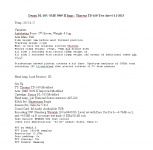 9 set-up.PNG31.5 KB · Views: 80
9 set-up.PNG31.5 KB · Views: 80 -
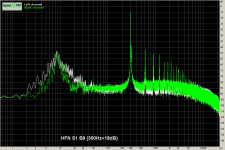 8 S1 B9 Spectrum.png39.1 KB · Views: 78
8 S1 B9 Spectrum.png39.1 KB · Views: 78 -
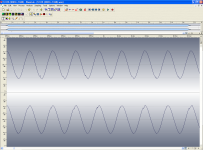 7 S1 B9 (300Hz+18dB).PNG91.9 KB · Views: 83
7 S1 B9 (300Hz+18dB).PNG91.9 KB · Views: 83 -
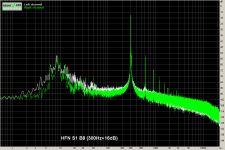 6 S1 B8 Spectrum.png38.2 KB · Views: 84
6 S1 B8 Spectrum.png38.2 KB · Views: 84 -
 5 S1 B8 (300Hz+16dB).PNG85.8 KB · Views: 90
5 S1 B8 (300Hz+16dB).PNG85.8 KB · Views: 90 -
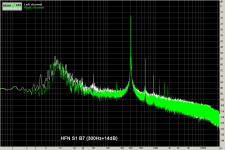 4 S1 B7 Spectrum.png38.1 KB · Views: 79
4 S1 B7 Spectrum.png38.1 KB · Views: 79 -
 3 S1 B7 (300Hz+14dB).PNG83.2 KB · Views: 141
3 S1 B7 (300Hz+14dB).PNG83.2 KB · Views: 141 -
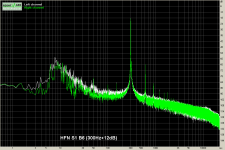 2 S1 B6 Spectrum.png37.9 KB · Views: 158
2 S1 B6 Spectrum.png37.9 KB · Views: 158 -
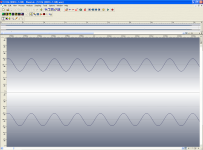 1 S1 B6 (300Hz+12dB).PNG79.9 KB · Views: 145
1 S1 B6 (300Hz+12dB).PNG79.9 KB · Views: 145
Is there a specific reason why the change in THD after repeated playing is just blamed on the LP.
Can't it be that the suspension of the cantilever is gradually getting different specs when playing a lot in a short time, while slowly restoring back to it's original behaviour when not being used for some time ?
With the Dr. Feickert test LP I get a different FR when not having used my TT for quite some time. Is the cause the LP or the cartridge ?
Since I use this test LP only very scarcely, to me the cartridge seems to be the obvious cause.
Hans
Can't it be that the suspension of the cantilever is gradually getting different specs when playing a lot in a short time, while slowly restoring back to it's original behaviour when not being used for some time ?
With the Dr. Feickert test LP I get a different FR when not having used my TT for quite some time. Is the cause the LP or the cartridge ?
Since I use this test LP only very scarcely, to me the cartridge seems to be the obvious cause.
Hans
I would concur, but George was always 'warming up' the cartridge' for at least 15 mins before hand. Certainly elastomer temperature is critical to performance, but I can't see it warming up much. Could be wrong (I often am).
I would concur, but George was always 'warming up' the cartridge' for at least 15 mins before hand. Certainly elastomer temperature is critical to performance, but I can't see it warming up much. Could be wrong (I often am).
What if the "warming up" takes much longer than 15 minutes to get to a final compliance and damping ? And should it really be seen as an increase in temp while playing, or is the elastomer more like a I cameleon?
Idon't know either, but I have read so many arguments, that to me the LP is at least doubtfull in causing the change in THD.
Hans
I suspect that many of us have thought about the cart and stylus changing, but wouldn't that show (disappear) in the tests delayed by hours? Does it?
An easy way to test that could be to use two identical LPs, one with many plays, the other without.
An easy way to test that could be to use two identical LPs, one with many plays, the other without.
Hi Hans
Yes. This is one of the variables I tried to neutralize, I don’t know how much succesfully.
A played for 15minutes a music vinyl before starting the recording of the 1 to 10 test tracks and again before any delayed playback (leaving out only the 7.5minutes delayed track).
Each 300Hz track was 18.3sec long. Each 1kHz track was 2 minutes long
George
Yes. This is one of the variables I tried to neutralize, I don’t know how much succesfully.
A played for 15minutes a music vinyl before starting the recording of the 1 to 10 test tracks and again before any delayed playback (leaving out only the 7.5minutes delayed track).
Each 300Hz track was 18.3sec long. Each 1kHz track was 2 minutes long
George
Attachments
Perhaps a simple way to detect if the it's the vinyl changing or the cart, is to use two carts.
If you do play 150 times with the Shure, record first with the Stanton. After 150 Shure plays, record again with the Stanton. If the vinyl has changed, that change should be recorded thru the Stanton, too. If the Stanton sees no change, we might assume that the Shure cart has changed.
For 300Hz or 1000Hz tones, 48K/24 bit should be plenty good enough.
If you do play 150 times with the Shure, record first with the Stanton. After 150 Shure plays, record again with the Stanton. If the vinyl has changed, that change should be recorded thru the Stanton, too. If the Stanton sees no change, we might assume that the Shure cart has changed.
For 300Hz or 1000Hz tones, 48K/24 bit should be plenty good enough.
Hi Hans
Yes. This is one of the variables I tried to neutralize, I don’t know how much succesfully.
A played for 15minutes a music vinyl before starting the recording of the 1 to 10 test tracks and again before any delayed playback (leaving out only the 7.5minutes delayed track).
Each 300Hz track was 18.3sec long. Each 1kHz track was 2 minutes long
George
George,
you did an admirable job, in the best possible way.
Hans
Yes, this seems a valid point IMO. And seems supported by the result that LF stability rank-correlates with number of tests/plays in George's 2.5g 300Hz+12dB tests.....it improves (!) I think that probably implicates the suspension: that only seems reasonable, and plausible.Is there a specific reason why the change in THD after repeated playing is just blamed on the LP.
Can't it be that the suspension of the cantilever is gradually getting different specs when playing a lot in a short time, while slowly restoring back to it's original behaviour when not being used for some time ?
Also, 300Hz@+12dB is continuous heavy duty playback, pretty much repetitive maximum displacement and maximum velocity to exercise the suspension spring and damping: perhaps even permanently alter it, or enough to have a long recovery time?
The 1kHz test George used for the Shure cartridge on the 3rd & final test suite is not as demanding/stressful, BTW. Of course, everything changed for that test: record, cartridge and stress. In a sense, it is a good test and interesting, because a quick look at all the files suggests that it doesn't show the same improvement trends for lf stability, test tone level, harmonic distortion nor noise floor with progressive playback as does the 2.5g 300Hz Stanton cart tests. But more on that later !
LD
Last edited:
in the best possible way.
Thank you Hans
But now I understand that those tests can not address the possible case you mention here.
What if the "warming up" takes much longer than 15 minutes to get to a final compliance and damping ?
Yesterday I run the “150 plays” test, the way Michael suggested (but with the cartridges swapped. Shure as the proof cartridge, Stanton as the 150 playback cartridge)
And before starting the x150 plays, I had the Stanton play a loud music LP for 90 minutes.
Who knows, 90 minutes may be enough time for the elastomer to settle to an equilibrium state.
George
Well a small amount of money appeared spare on the budget this month and I suddenly discovered that stylus angst exists! My original plan had been to get one of my MCs re-tipped, so I had a reference to measure the success of the MM experiments against, then I realised that money 'might' be more usefully diverted to frankencartridge experiments we have been discussing. But in doing the research (I've only ever run ellipticals of one sort or another) I realise that there is absolutely zero correlation between different high end tips between various pundits and there are very few credible measurements to examine. In a way this is comforting as it suggests that they are all much of a muchness and it comes down to cost and lifetime. I mean Benz micro changed from FGS to microline with zero fanfare (although what they are doing now that microline appear to be in short supply I don't know). My heart still says that the top of the line Gyger should, if correctly controlled give the best results, my head points out its twice the price of most of the other options. Tricky. Thank heavens the the Weinz papers from the 70s! (have these if anyone wants along with the SEMs of CD4 groove wear).
I've also noticed a lot of serial cartridge buyers out there who as far as I can tell, but something, listen for a week then go 'oooh shiny' and buy the next, which probably explains the complete confusion and chaos reigning out there. It does suprise me how many people still run the high end OM series though. Either they can't be bothered to change or it really is rather good. For amusement OM vs 2M threads are always a hoot! But nothing useful. Not sure why I ever thought there would be
Anyway how does all this affect this thread? Well If I retire my 18 year old Benz and put my AT-150MLx in its place I have arguably one of the top cartridges for accuracy and neutrality* and I can then concentrate the limited funds on a frankenmod to one of the OM stylii. Now the fundamental goal is/was to see if a low compliance suspension makes a difference and would give us our cake and a nibble of it as well. First step in this is to find out if the cantilevers can swapped without messing things up. I'll email ESCO and ask.
Assuming that is possible then the question is what to stick in and what to keep as a baseline.
Option 1 Stylus 40 (Gyger 70) into S-120 suspension
Option 2 sapphire cantiliver and paratrace into S-120 (cut and shut)
Option 3 Paratrace stylus onto stock S-120 cantilever. **
Although I think it would be very useful to get some data on the sapphire mod to see if LD is right and I will be getting a quote. I have found a good price for the Stylus 40 which seems to make that almost a no brainer. BUT not sure I can stretch to two of them to keep a baseline so LD (who I believe still uses a 40) would need to be willing to do the side to side comparisons if I send the mutant to him. What do people reckon? certainly as LD AND Richard are in agreement on lower compliance being of interest something needs to be done.
Thoughts?
*I realise the logical fallacy to this which is that statement makes the AT-OC9II the top MC.
**And there was an option 4, which was the FG-S stylus, but at £375 for the re-tip alone that's too spendy for me at the moment.
I've also noticed a lot of serial cartridge buyers out there who as far as I can tell, but something, listen for a week then go 'oooh shiny' and buy the next, which probably explains the complete confusion and chaos reigning out there. It does suprise me how many people still run the high end OM series though. Either they can't be bothered to change or it really is rather good. For amusement OM vs 2M threads are always a hoot! But nothing useful. Not sure why I ever thought there would be
Anyway how does all this affect this thread? Well If I retire my 18 year old Benz and put my AT-150MLx in its place I have arguably one of the top cartridges for accuracy and neutrality* and I can then concentrate the limited funds on a frankenmod to one of the OM stylii. Now the fundamental goal is/was to see if a low compliance suspension makes a difference and would give us our cake and a nibble of it as well. First step in this is to find out if the cantilevers can swapped without messing things up. I'll email ESCO and ask.
Assuming that is possible then the question is what to stick in and what to keep as a baseline.
Option 1 Stylus 40 (Gyger 70) into S-120 suspension
Option 2 sapphire cantiliver and paratrace into S-120 (cut and shut)
Option 3 Paratrace stylus onto stock S-120 cantilever. **
Although I think it would be very useful to get some data on the sapphire mod to see if LD is right and I will be getting a quote. I have found a good price for the Stylus 40 which seems to make that almost a no brainer. BUT not sure I can stretch to two of them to keep a baseline so LD (who I believe still uses a 40) would need to be willing to do the side to side comparisons if I send the mutant to him. What do people reckon? certainly as LD AND Richard are in agreement on lower compliance being of interest something needs to be done.
Thoughts?
*I realise the logical fallacy to this which is that statement makes the AT-OC9II the top MC.
**And there was an option 4, which was the FG-S stylus, but at £375 for the re-tip alone that's too spendy for me at the moment.
- Home
- Source & Line
- Analogue Source
- mechanical resonance in MMs
